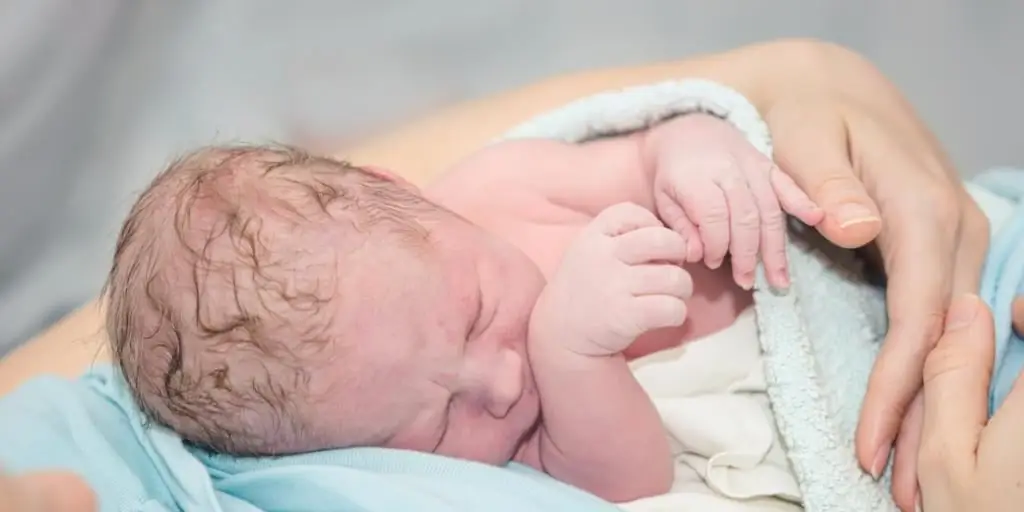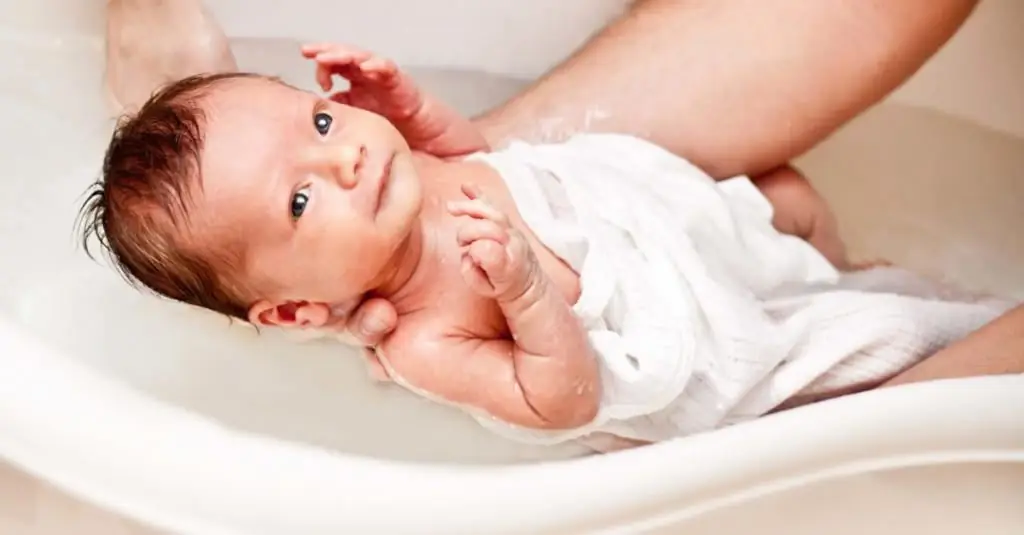2026 Author: Priscilla Miln | [email protected]. Last modified: 2025-01-22 17:55:16
Immediately after birth, the baby's umbilical cord is cut. For some time in this area there is a wound that requires the care that a newborn needs. Processing of the umbilical cord is carried out at home and requires the use of pharmacy products and knowledge of the correct algorithm of actions.
About the umbilical cord
While the baby is in the womb, the umbilical cord plays an important role. She is the link between the child and the mother. The umbilical cord in childbirth is de alt with immediately. The fact is that the three vessels passing inside it are open gates for the surrounding air and infection.

After the baby is born, he independently adapts to life outside the mother's womb, so he no longer needs an umbilical cord.
Immediately after the baby is born, the umbilical cord is cut off. After this manipulation, a small residue remains, which is clamped with a special clothespin in the maternity hospital.
About 10 days this balancegradually hardens and dries. After that, this process will completely fall off. To speed up this process, you need to know how to properly care for the umbilical wound, what means can be used.
Primary and secondary treatment of the umbilical cord of a newborn
This process is carried out in the maternity hospital. Before the birth, the midwife treats the hands according to accepted hygiene standards.

After the umbilical cord stops pulsing, two Kocher clamps are applied to it. One is located at a distance of 10 cm from the umbilical ring, and the second at a segment of 2 cm outside of it. The area that is between the two clamps is treated with iodine, and then it is crossed

Secondary treatment of the umbilical cord of a newborn is to transfer the child on a special tray to the changing table. After that, the midwife again processes the hands, and then, with the help of the thumb and forefinger, tightly clamps the umbilical cord. Then a sterile staple made of Rogovin's metal is placed in special forceps. The umbilical cord between the brackets of the bracket is positioned so that its lower edge is at a distance of 0.5 to 0.7 cm from the edge of the navel. After that, the tongs close until they click
Maternity care
The primary treatment of the umbilical cord of a newborn requires proper hygiene care. Processing the navel in the maternity hospital can be done in different ways:
- Open way. A metal clip is put on the umbilical residueor plastic. Until the discharge of the newborn, the residue is treated daily with hydrogen peroxide. After 5 days, the process falls off, and a small wound remains in its place.
- The second way. On the second day after the birth of the crumbs, the remainder is cut off with a surgical instrument, and then a pressure sterile bandage is applied. After two hours, it is weakened, and after a day it is completely removed. The remaining wound is treated daily with potassium permanganate and hydrogen peroxide.
Baby Bathing
Carrying out hygiene procedures is a fairly simple process. Despite this, parents often have questions related to bathing their baby in the first days after discharge from the maternity hospital.
When there is a clothespin on the umbilical cord, you can bathe the baby. The baby should take water procedures in his own bath. Until the wound heals, the bathing water must be boiled. It is very important to use a water thermometer. In the first month of a baby's life, bathing should not last long.
Remember that you can’t put the baby on the stomach until the navel heals, otherwise you risk injuring it.
Do not add potassium permanganate to bathing water. The product is very dry for the delicate skin of the baby. The same applies to pharmaceutical herbs. Do not get carried away with bathing cosmetics, it is enough to use them once a week.
Basic rules
The primary and secondary treatment of the umbilical cord of a newborn is sometimes carried out according to the old scheme. This is due to the fact that the opinions of pediatricians today regarding the conduct of thisprocedures are very inconsistent. According to the old scheme, the umbilical wound must be dried, which means that you cannot treat it with anything and wet it for a week. This is a rather dubious method, but it is often used by young mothers on the advice of grandmothers. We will consider the second technique later.

The choice of processing method is chosen by the parents themselves. In the process of care, it is very important to be as careful as possible in order not to accidentally introduce an infection into the wound.
Many mistakenly believe that the navel will heal for a long time if the baby is bathed. For quick healing of the wound, you can and should bathe the baby. After water procedures, it is necessary to proceed to the scheme below and process the navel of the newborn.
Action algorithm
Let's consider the basic procedure that must be followed in the process of caring for the umbilical wound. By following the correct care procedures, you can avoid common mistakes.
- Lay the baby on a horizontal surface. Place a soft blanket under it. Remember that the baby should feel as comfortable as possible.
- Apply a few drops of hydrogen peroxide solution to the wound.
- Wait a while for the crusts to soften.
- After that, the navel must be gently pushed apart with a sterile cotton swab in order to remove all crusts.
- After apply the medicine you prefer to care for the umbilical wound.
Important! You can not open the wound, butalso tear off the remnants of the umbilical cord. Such negligence can provoke an infection in the unhealed navel. It will be difficult to solve such a problem in the future, so take the procedure responsibly.

Caring for the umbilical wound is enough to carry out once a day. It is better to do this after water procedures, because after bathing in warm water, the crusts soften naturally.
Popular cord treatments
Specialists highlight traditional products and novelties. It is very important to use them correctly, as improper use can lead to sores and burns.
Traditional remedies:
- 3% hydrogen peroxide solution. Buried in the umbilical fossa.
- An alcoholic solution of hydrogen peroxide is needed to treat the umbilical ring. For this purpose, you can use a cotton swab.
- 2 or 5% potassium permanganate solution. Such a tool perfectly disinfects and dries the wound. But remember, before you treat the umbilical wound with a solution of potassium permanganate, you need to pass it through several layers of gauze bandage, it will hold all the crystals that have not dissolved.
Of the new products, a 1% solution of chlorophyllipt is popular. This is a natural preparation that is made from eucalyptus extract. The tool has proven itself in the fight against streptococcal infection.

More recently, it was customary to treat the umbilical wound with brilliant green. Today more and morepediatricians recommend not to use this method, as this solution contributes to the formation of a film on the skin, which prevents rapid healing.
Long healing
Often, young mothers are faced with a situation where the wound heals for a long time in a newborn. The umbilical cord is processed correctly, but there are no positive changes. Unfortunately, this is not always the case! The fact is that with proper care, the umbilical wound heals within a week. If this does not happen, then you should consult a doctor for advice. You may be doing something wrong.

Sometimes young mothers are faced with a situation where the umbilical cord of a newborn bleeds. Treatment at home in this case involves caring for the wound more than once a day. But remember that in order to avoid possible infection in an open wound, it is better to consult a pediatrician.
If the navel does not heal after three weeks, then you should definitely consult a doctor. Unfortunately, this may be the result of an infection, and the wound could fester.
Possible problems
Primary processing of the umbilical cord of a newborn and the algorithm of actions must be performed correctly. Sometimes you can notice sanious discharge, they are the norm if they pass soon.
Minor bleeding can be caused by:
- Baby's navel may have been touched by clothes or a diaper while changing.
- Mommy overdid it on the wound andaccidentally injured the fabric.
- The baby cried loudly for a long time, as a result, the crust on the navel cracked.
Symptoms that indicate possible inflammation:
- Frequent and prolonged symptoms of bleeding from the navel.
- Discharge with an admixture or smell of pus.
- Redness around the navel and fever in this area.
- Unpleasant smell that comes from the wound.
- The navel does not heal for more than three weeks.
All of the above symptoms require immediate medical attention, as they indicate that an infection has entered the wound.
Remember that the immunity of the newborn is not yet formed, and the body cannot cope with infections on its own, as it is rather weak. If timely measures are not taken to the disease, then serious consequences can be provoked.
Recommended:
Cutting the umbilical cord: cutting technique and clamping, timing

The birth of a child is an exciting and responsible process not only for parents, but also for the baby. If possible, it should proceed naturally and as easily as possible - the state of he alth of both depends on this. And now the newborn is on the mother's stomach, and after a while the doctors proceed to another mandatory procedure - cutting the umbilical cord. But does everyone understand exactly when this should happen? Meanwhile, the condition of the child largely depends on this
Short umbilical cord: causes, consequences for the child and mother

Doctors call the umbilical cord the umbilical cord. It connects a small embryo, which later becomes a fetus, to the placenta. With the help of such a kind of "bridge" the child's body is connected with the mother throughout the entire period of pregnancy. Communication is maintained until the very birth. There are norms for the length of the strand, but in some cases it can be longer or shorter. Both a short umbilical cord and a long one can lead to negative consequences
Do I need to boil water for bathing a newborn: rules for bathing a newborn at home, water sterilization, adding decoctions, folk recipes and recommendations from pediatricians

Bathing a small child is not only one of the ways to keep the body clean, but also one of the ways to stimulate breathing, blood circulation in the body. Many parents ask themselves questions: is it necessary to boil water for bathing a newborn, how to choose the right temperature and where to start the water procedure
Rules for caring for the umbilical wound of a newborn

The first few weeks after the birth of a newborn baby is a difficult time for all parents. Especially if the firstborn was born. Newly minted moms and dads are worried about a lot of questions regarding the rules for the care and hygiene of crumbs
Marginal attachment of the umbilical cord to the placenta: reasons, what threatens, how the pregnancy proceeds

The marginal attachment of the umbilical cord to the placenta is a relatively rare reason for the experiences of the expectant mother. However, such an anomaly of fixation of the umbilical cord in some cases (especially if complicated by other problems) can cause heavy bleeding during childbirth and death of the fetus. To reduce the risks, a pregnant woman may be advised to have a caesarean delivery

